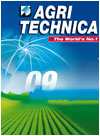 Experts expect price increases in second half of 2009 with wheat in the Paris exchange rising to 200 €/t. Recommendations include forward selling when prices high.
Experts expect price increases in second half of 2009 with wheat in the Paris exchange rising to 200 €/t. Recommendations include forward selling when prices high.The worldwide economic crisis could reduce production of grain and oilseeds and see prices pushed upwards by autumn of this year according to financial analyst Jochen Hitzfeld from UniCredit, Munich. He was speaking at the DLG’s “Wintertagung” conference in Berlin, January. And his predictions were good news for the investment climate at the world’s largest farm equipment exhibition, Agritechnica, 10 -14 November (preview days 8 and 9) where specialists from all over the world gather to learn about, and invest in, the latest technology solutions for efficient agriculture.
Behind the expected price boom is the difficulty, especially in emergent countries, of getting credit – a situation already stopping expansion of agricultural production in Russia and the Ukraine, at least for the moment, according to Hitzfeld. On top of this, global reduction in demand for fertiliser and plant protection sprays could have a negative effect on yields this harvest. Following farm product price reductions in the last months, cropping on 30% of the most expensive production areas was no longer profitable, leading to an over 10% reduction in northern hemisphere growing area.
But another expert at the DLG Wintertagung, Frank Gagel of traders Schouten Ceralco in the Netherlands, warned of continued fluctuations in wheat price. Bread wheat at the Paris Exchange (MATIF) wouldn’t go lower than 130 €/t, he felt. Mills and feed plants still needed substantial supplies for production up to the new harvest. So there was plenty of room for price rises up to 200 €/t.
Dr. Rüdiger Fuhrmann from the Norddeutschen Landesbank (NordLB) did not expect farmers to have difficulties in getting credit because of the current economic downturn. Agriculture has a good reputation amongst banks due to its relatively low failure rate and because, from the credit institutes’ point of view, farm businesses behaved well during the recent bull market. Even compared with medium-sized businesses, the farming sector is small-structured with credit risks thus spread widely. However, a more rigorous selection procedure for credit is now expected and farmers will have to establish suitable control and risk management instruments if they wish to be credit worthy in future.
Austrian farmer Maximilian Graf Hardegg reassured the 700-strong Wintertagung audience that agriculture was still in a good position despite the current turbulent market. The growing world population would continue to need a steady food supply. But German farmer Deert Rieve from Mecklenburg-Vorpommern warned of the liquidity trap. Volatile price fluctuations meant variations in margins the size of which had never before been experienced, he pointed out. Input costs and product selling price must therefore be more closely controlled than ever before. Those enterprises already struggling under the burden of debt could only expect conditions to worsen, he felt. And he called for more attention to unit costs: business risks were linked with the size of these and so reducing the unit costs reduced the financial risks. In a volatile market precise knowledge of unit costs was also crucial in determining time of product sale.
Imperative in such markets was the possibility of short-term adjustment of land rents, reckoned Rieve. Additionally, investments needed to be adjusted to match more closely fluctuating liquidity. Finally, new business strategies for deflation and inflation phases needed to be developed. Inflation had the effect of depleting reserves of high performance businesses and so in such cases investment was often better than adding to capital reserves.
Grain shortage expected
Commodity expert Hitzfield expected a significant grain deficit in the coming fiscal year. He predicted world wheat production would fall from 676 million tonnes to 627 m t. Consumption would remain stable since the drop in transport costs would probably cause increased demand from typical deficit regions.
Even a more conservative estimate with demand remaining unchanged at 652 m t could result in world stocks being reduced from 140 to 115 m t in 2009/10 which meant only a 62 day supply for the world population after the end of the season, reckoned Hitzfeld. “Then we are very rapidly back to the price highs where we were 15 months ago.”
Adverse weather conditions could also cause a new wave of export embargos and excessive speculation. In this case, a justified price increase of 30% could rapidly become a doubling of price for the most important food grains, leading possibly to new protests at more expensive foods.
Don’t be greedy!
Grain dealer Frank Gagel warned the whole sector to forget about wringing the “last Euro” out of every deal. In the future, buyers’ and sellers’ markets would alternate frequently and this meant a need for a new partnership between trade and agriculture. Supply the market regularly and, where prices are right, make the occasional delivery contract, Gagel advised farmers. “When costs are covered and the profit margin is acceptable, as farmer I must get rid of my product.” Taking the example of spring 2008 he said that it was hard to understand from a dealer’s point of view why, with total production costs for wheat at around 150 €/t, many farmers had failed to part from their ware although buyers were offering at times more than 250 €/t.
http://www.agritechnica.com/index.php?struts=publicArtikelDetail.do&id=1592&artikelId=2227&kategorieId=10&spracheId=2&bereich=News



